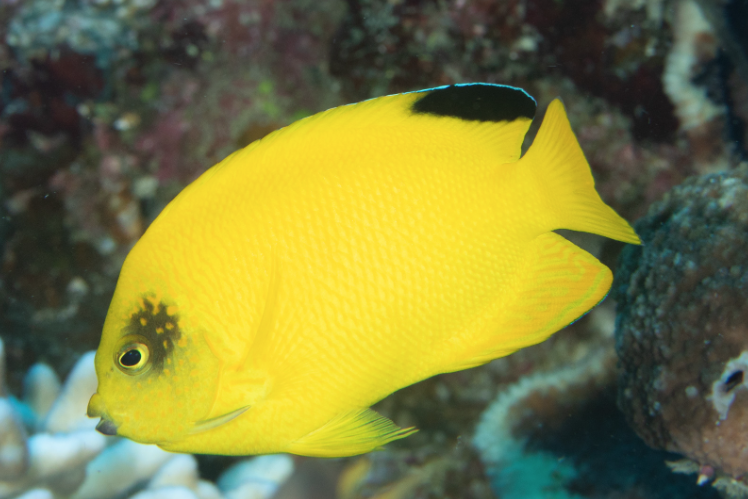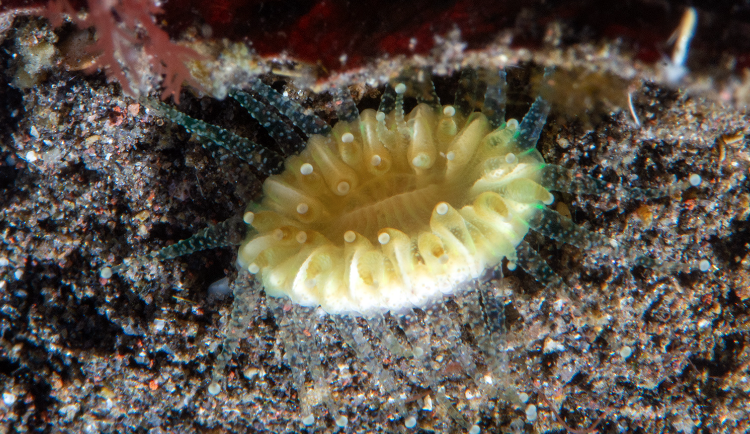The marine angelfish family Pomacanthidae is, generally speaking, a very well-understood group. These are some of the most colorful and charismatic fishes found in reef ecosystems, and so they have naturally attracted more than their fair share of taxonomic attention. With the description of Fiji’s Centropyge deborae in 2012 and the microendemic Centropyge cocosensis in 2016, we have just about run out of new species to describe—the last of these is likely to be the Black Phantom Angelfish from the Northwest Pacific. But there are still some remaining nomenclatural nits to pick: Centropyge fisheri vs Centropyge flavicauda… Indian Ocean vs Pacific Ocean Pomacanthus imperator… and Centropyge heraldi vs Centropyge woodheadi.
This last example may prove to be the most intractable to sort out thanks to a confusing discordance between the coloration, biogeography, and molecular data for this species pair. Let’s take a moment to review what we know, but *spoiler alert* there’s not going to be any fulfilling consensus reached by the end of this article. Sorry.
The Yellow Angelfish C. heraldi was a surprisingly late discovery in its genus. The species first popped up in a 1943 book, Coral Fishes, by the Japanese ichthyologist Hyoji Aoyagi (1912–1971), who had collected it in Okinawa, though Aoyagi-san erred in confusing his specimen with another yellow species, the Lemonpeel Angelfish C. flavissima (which is in fact absent from Okinawa). This was soon corrected in a 1953 paper by Woods & Schultz, describing C. heraldi using specimens from Bikini Atoll; this type series had been collected just weeks after the nearby testing of nuclear weapons in 1946, possibly making these the only radioactive type specimens in the history of ichthyology.
It would be nearly a half-century before someone bothered to notice that specimens of C. heraldi from Fiji looked a bit different, possessing a distinctive black tip in the dorsal fin. That someone was Australian ichthyologist Rudie Kuiter, who described C. woodheadi in 1998 from a single specimen, along with noting the presence of a similar population at Holmes Reef in the middle of the Coral Sea. But almost immediately this was met with resistance within the scientific community; in a 2000 paper by Jack Randall and Bruce Carlson, it was noted that captive specimens would sometimes lose this black marking, suggesting to these authors that Kuiter’s woodheadi was merely a color morph of a single widespread Central Pacific species.
And that’s how things stood until a 2016 revision by Shen et al, which for the first time attempted to address this issue by looking at genetic data. These authors examined specimens of both phenotypes, mostly acquired via the aquarium trade, from throughout their known range: the Philippines, Taiwan, the Great Barrier Reef, Vanuatu, Fiji, Tonga, & French Polynesia. The results were surprising, to say the least, and continue to cause confusion to this day.

Rather than revealing a single, widespread species or a pair of phenotypically distinct species, the genetic data instead pointed towards a sharp north-south biogeographic break in the Pacific. Specimens from the north correspond to the typical Yellow Angelfish phenotype, ranging from Brunei in the west to Kiritimati in the east; on the other hand, the southern population, occurring from the Great Barrier Reef to Pitcairn, is composed of a mix of both phenotypes, but unequally distributed across this range. The black-tipped woodheadi color morph is dominant in the middle, at Vanuatu, Fiji, Samoa, Tonga, and Nieu, completely replacing its yellow-finned counterpart. Strays seems to occur elsewhere, including the Coral Sea and perhaps also neighboring portions of Papua New Guinea and the Solomon Islands, though these latter regions remain very poorly documented; likewise, it has been reported from the Cook Islands and French Polynesia, though I have yet to see a specimen to confirm this. Rather, the yellow-finned phenotype replaces the black-tipped phenotype entirely (or nearly so) in much of the west (Australia, New Caledonia) and the east (the Cook Islands, French Polynesia, Pircairn).
Molecular data doesn’t lie. The disconnect between phenotype and genotype in the South Pacific is an anomaly, but we have to presume that it reflects the actual evolutionary history of this fish. But why? How did we end up with a well-defined woodheadi around Fiji, bookended by a couple of faux-heraldi elsewhere? That is, unfortunately, where this story ends, as there’s not really a convincing explanation. It’s important to note that the study by Shen et al only investigated 3 genes, so it is plausible that a more robust molecular toolkit will reveal further differences, splitting woodheadi into distinct populations centered on the Coral Sea, Melanesia, and Polynesia, respectively… though there’s not much of a precedent for such a fine-scale endemism amongst Indo-Pacific pomacanthids. For comparison, consider the relatively homogenous populations of the Flame Angelfish C. loriculus and the Lemonpeel Angelfish, which share nearly identical distributions in the Central Pacific. Why would heraldi & woodheadi speciate when these other Pacific pygmies failed to do so?
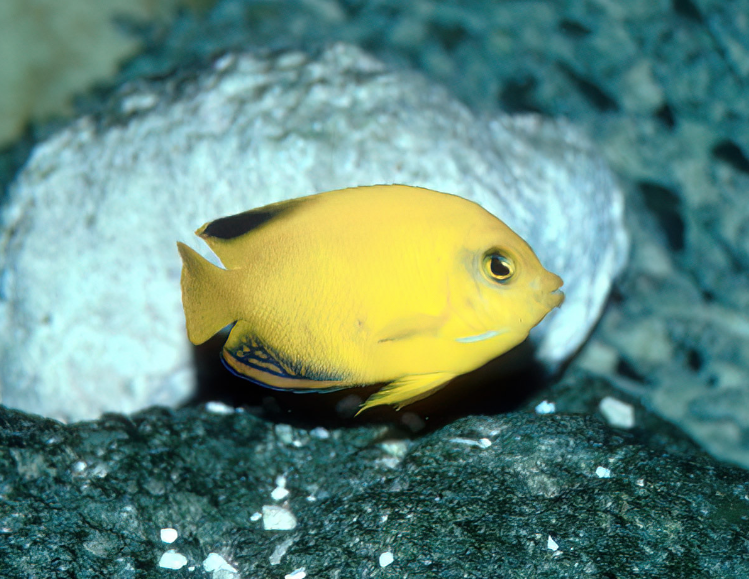
Adding to our confusion is the frequent presence of melanistic specimens throughout the range of both the northern and southern populations, further blurring any phenotypic distinction between heraldi and woodheadi. There is also an aberrant color morph of the closely related Bicolor Angelfish that approximates the black & yellow color palette of woodheadi, occurring sympatrically with it in Fiji and perhaps even representing a hybrid of these species. This additional layer of phenotypic variation calls into question some of the records of woodheadi from outside of its core range, particularly those from Polynesia. In general, melanistic specimens tend to have a more widespread and diffuse darkening to the fins, often extending far beyond what we see in topotypical specimens of woodheadi, but occasional specimens do come very close to it—a diagnostic trait that seems to be useful for identifying these is whether the margin of the dorsal fin is blue (woodheadi) or yellow (heraldi).
At the conclusion of their paper, Shen et al make it clear that they consider woodheadi to be an allopatric sister species of a more narrowly defined heraldi, restricted solely to the north; they even suggest the Polynesian term for this fish, paraharaha, as a common name, rather than the misleading Blackfin Pygmy Angelfish. Unfortunately, this revision has been inconsistently applied in the years since.
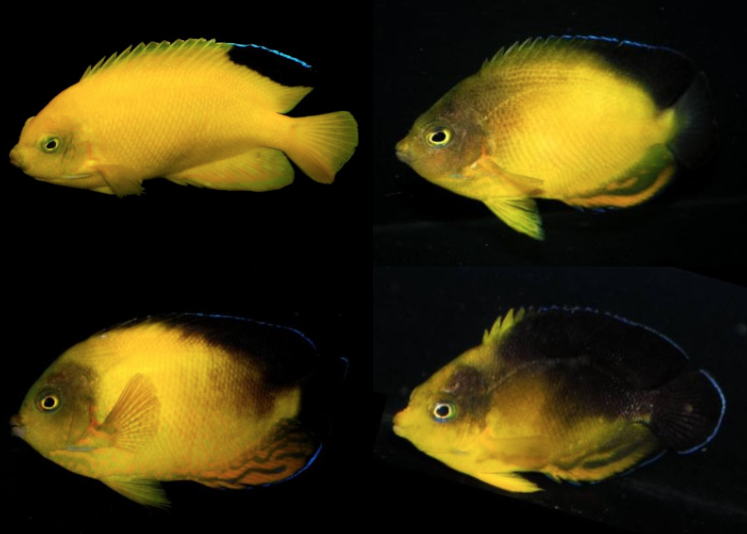
Catalog of Fishes still lists the range of C. heraldi as encompassing all of the Central Pacific, while also recognizing C. woodheadi as a valid species occurring from, “[the] Great Barrier Reef to [the] Gambier Archipelago”. Fishbase follows the distributions given by Shen et al verbatim, but they repeat an error from that paper, suggesting that C. heraldi also occurs at Sri Lanka and Bali—both of these records originate from aquarium wholesalers, rather than from verified specimen data. Vincent Chalias reports that the only known Indonesian population occurs at the Sangihe Islands north of Sulawesi, presumably seeded from nearby Palau via the powerful westerly currents of the Indonesian Throughflow; additional records exist from Davao and possibly the Derawan Islands, but the full extent of its distribution in the Celebes Sea remains to be seen. Wikipedia, that bastion of infallible encyclopedic knowledge, confidently states a range for heraldi throughout the Central Pacific, entirely without mention of C. woodheadi (though it is at least listed as a valid species on the page for Centropyge). Lastly, iNaturalist incorrectly limits woodheadi to its distinctive black-tipped phenotype, resulting in a peculiar non-Melanesian allopatry for C. heraldi.
In total, the websites that are most likely to be consulted for accurate biogeographic data all give their own distinct interpretation on the species limits, none of which are correct. Oy vey! Is it any wonder that these angelfishes continue to create confusion. Despite the best efforts of the Shen et al study, the evolutionary history of these species remains clouded in uncertainty and will likely require an even more exhaustive genetic investigation to resolve.
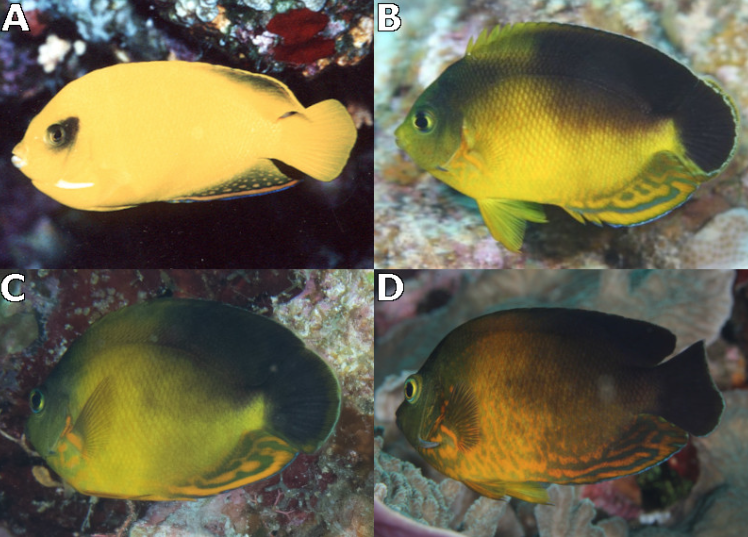
An Etymological Addendum
Centropyge heraldi is named after ichthyologist Earl Stannard Herald (1914–1973). After earning a PhD from Stanford with a dissertation on the classification of American pipefishes, Herald joined the US Army during World War 2, rising to the rank of Captain; his prior experience in ichthyology led him to be put in charge of studying the effects of nuclear radiation on the marinelife at Bikini Atoll. Herald and Leonard Schultz were both stationed there in 1946 when the type specimens were collected, though it’s not specified if Herald was the collector; he also authored the pipefish chapter from the 1953 paper that described his angelfish, Fishes of the Marshall and Marianas Islands. Herald would later become a Curator of Aquatic Biology, and eventually Associate Director, of the Steinhart Aquarium, while also hosting a long-running television show from 1952–1966, Science in Action (through the magic of YouTube, you can watch him creating Plutonium on live television with Nobel prize-winner Glenn Seaborg! Don’t worry, I’m sure those labcoats protected them from the radiation.). He was the author of 28 new species, mostly pipefishes, and, in addition to C. heraldi, there are a half-dozen other species named after him, as well as Australia’s peculiar upside-down pipefish, Heraldia nocturna. He also coauthored Pacific Coast Fishes in the hugely popular Peterson Field Guides series. Sadly, Earl Herald passed away during a dive in Mexico while chasing after a Clarion Angelfish—an unfortunate, but fitting, way to go for this intrepid explorer of reef fishes.
Centropyge woodheadi is named for Phil Woodhead, an underwater photographer who alerted Rudie Kuiter of the black-tipped phenotype in the Coral Sea. Sometimes, being in the right place at the right time is all one needs to get an eponymous angelfish.
